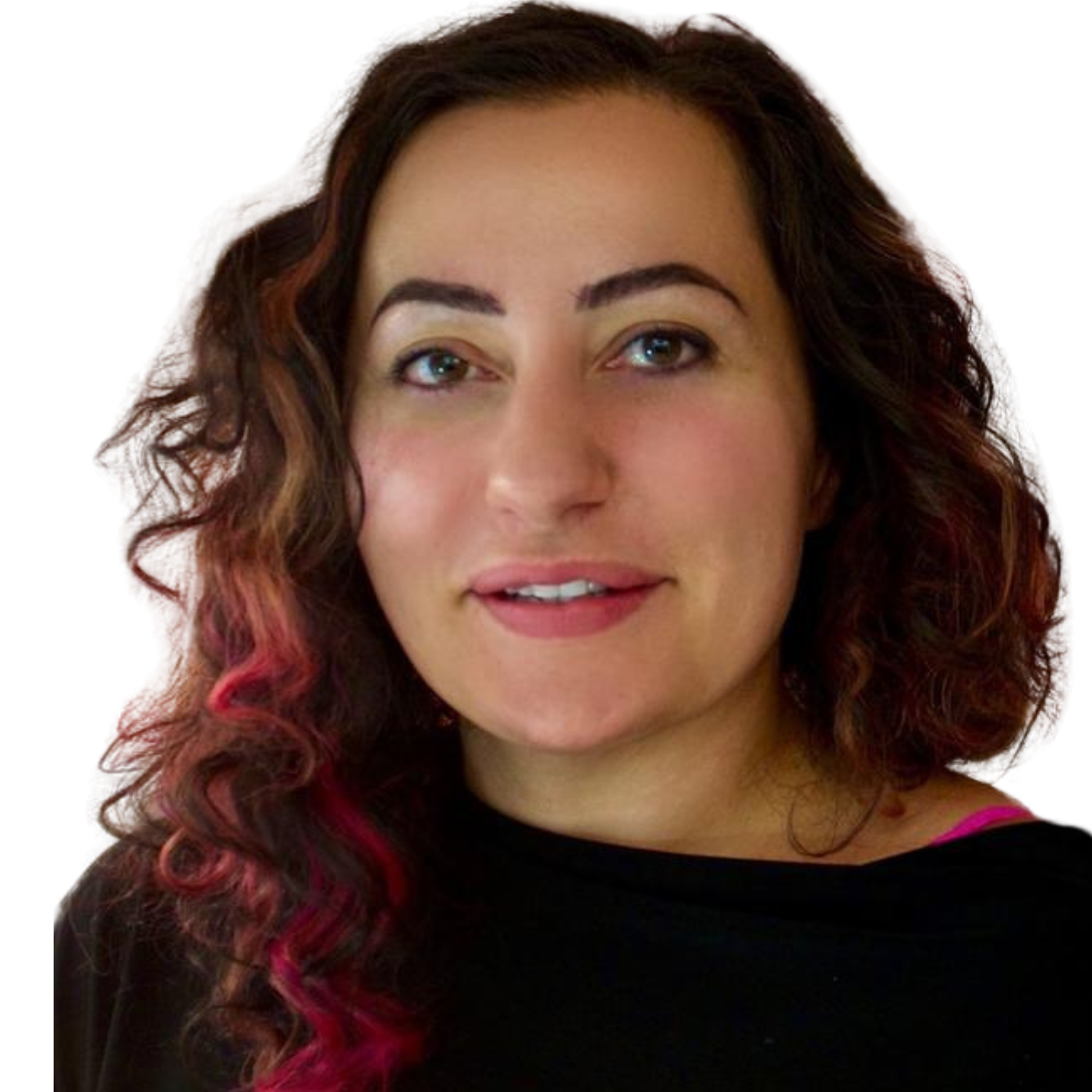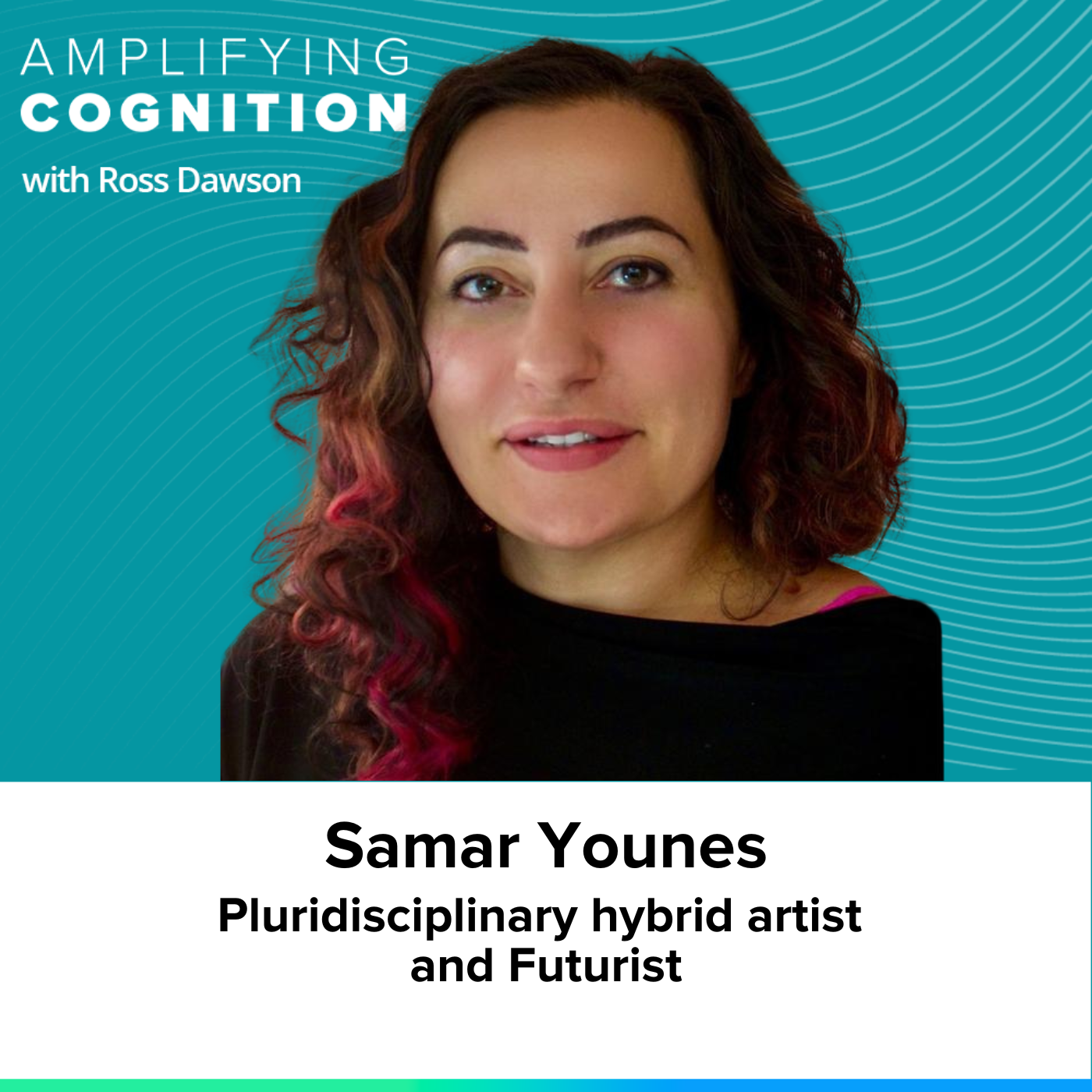“To me, envisioning a future should involve elements anchored in nature, modern materials, and sustainable practices, challenging Western-centric constructs of ‘futuristic.’ Artisanal intelligence is about understanding material culture, combining traditional craft with modern techniques, and redefining what feels ‘modern.’”
– Samar Younes

About Samar Younes
Samar Younes is a pluridisciplinary hybrid artist and futurist working across art, design, fashion, technology, experiential futures, culture, sustainability and education. She is founder of SAMARITUAL which produces the “Future Ancestors” series, proposing alternative visions for our planet’s next custodians. She has previously worked in senior roles for brands like Coach and Anthropologie and has won numerous awards for her work.
What you will learn
- Exploring the intersection of art, AI, and cultural identity
- Reimagining future aesthetics through artisanal intelligence
- Blending traditional craftsmanship with digital innovation
- Challenging Western-centric ideas of “modern” and “futuristic”
- Using AI to amplify narratives from the Global South
- Building a sustainable, nature-anchored digital future
- Embracing imperfection and creativity in the age of AI
Episode Resources
Transcript
Ross Dawson: Samar, it’s awesome to have you on the show.
Samar Younes: Thank you so much. Thanks for having me.
Ross: So you describe yourself as a plural, disciplinary hybrid, artist, futurist, and creative catalyst. That sounds wonderful. What does that mean? What do you do?
Samar: What does that mean? It means that I am many layers of the life that I’ve had. I started my training as an architect and worked as a scenographer and set designer. I’ve always been interested in bringing public art to the masses and fostering social discourse around public art and art in general.
I’ve also always been interested in communicating across cultures. Growing up as a child of war in Beirut, among various factions—religious and cultural—it was a diverse city, but it was also a place where knowledge and deep, meaningful discussions were vital to society. Having a mother who was an artist and a father who was a neurologist, I became interested in how the brain and art converge, using art and aesthetics to communicate culture and social change.
In my career, I began in brand retail because, at the time, public art narratives and opportunities to create what I wanted were limited. So I used brand experiences—store design, window displays, art installations, and sensory storytelling—as channels to engage people.
As the world shifted more towards digital, I led brands visually, aiming to bridge digital and physical sensory frameworks. But as Web3, the metaverse, and other digital realms emerged, I found that while exciting, they lacked the artisanal textures and layers that were important to me. Working across mediums—architecture, fashion, design, food—I saw artificial intelligence as akin to working with one’s hands, very similar to what artisans do. That’s how I got into AI, as a challenge to amplify narratives from the Global South, reclaiming aesthetics from my roots.
Ross: Fascinating. I’d love to dig into something specific you mentioned: AI as artisanal. What does that mean in practice if you’re using AI as a tool for creativity?
Samar: Often, when people use AI, specifically generative AI with prompts or images, they don’t realize the role of craftsmanship or the knowledge of craft required to create something that resonates. Much digital imagery has a clinical, dystopian aesthetic, often cold and disconnected from nature or biomorphic elements, which are part of the world crafted by hand.
To me, envisioning a future should involve elements anchored in nature, modern materials, and sustainable practices, challenging Western-centric constructs of “futuristic.” Ancient civilizations, like Egypt’s with the pyramids, exemplify timeless modernity. Similarly, the Global South has always been avant-garde in subversion and disruption, but this gets re-appropriated in Western narratives. Artisanal intelligence is about understanding material culture, combining traditional craft with modern techniques, and redefining what feels “modern.”
Ross: Right. AI offers a broad palette, not just in styles from history but also potentially in areas like material science and philosophy. It supports a pluriplinary approach, assisted by the diversity of AI training data.
Samar: Exactly. When I think of AI, I see data sets as materials, not just images. If data is a medium, I’m not interested in recreating a Picasso. I see each data set as a material, like paint on a palette—acrylic, oil, charcoal—with the AI system as my brush. Creating something unique requires understanding composition, culture, and global practices, then weaving them together into a new, personal perspective.
Ross: One key theme in your work is merging multiple cultural and generational frames using technology. How does technology enable this?
Samar: Many AI tools are biased and problematic. When I tried an exercise creating a “Hello Kitty” version in different cultural stereotypes, I found disturbing, inaccurate, or even racist results, especially for Global South or Middle Eastern cultures. To me, cultures are fluid and connected, shaped by historical nomadism rather than nationalistic borders.
My concept of the “future ancestor” explores sustainability and intergenerational, transcultural constructs. Cultures have always been fluid and adaptable, but modern consumerism and digital borders often force rigid identity constructs. In prompting AI, I describe culture fluidly, resisting prescribed stereotypes to create atypical, nuanced representations.
Ross: Agreed. We’re digital nomads today, traveling and exploring in new ways. But AI training data is often Western-biased, so artists can’t rely on defaults without reinforcing these biases.
Samar: The artist’s role is to subvert and hack the system. If you don’t have resources to train your own model, I believe there’s power in collectively hacking existing models by feeding them new, corrective data. The more people create diverse data, the more it influences these systems. Understanding how to manipulate AI systems to your needs helps shape their evolution.
Ross: Technology is advancing so quickly, transforming art, expression, and identity. What do you see as the implications of this acceleration?
Samar: I see two scenarios: one dystopian, one more constructive. Ideally, technology fosters nurturing, empathetic futures, which requires slower, thoughtful development. The current speed, however, is driven by profit and the extractive aims of industrialization—manipulating human needs for profit or even exploiting people without compensation. This dystopia is evident in algorithmic manipulation and censorship.
I wish the acceleration focused on health and well-being rather than extractive technologies. We should prioritize technologies that support work-life balance, health, and sustainable futures over those driven by profit.
Ross: Shifting gears, can you share more specifics on tools you use or projects you’re working on?
Samar: Sure. I use several tools like Cloud, ChatGPT, Runway ML for animations, and Midjourney for visuals. I have an archive of 50,000+ images I’ve created, nurturing them over time, blending them across tools. Building a unique perspective is key—everyone has a distinct point of view rooted in their cultural and personal experiences. Recent projects include my “Future Ancestor” project and a piece called “Future Custodian,” which I co-wrote with futurist Geraldine Warri. It’s a speculative narrative about a tribe called the “KALEI Tribe,” where fashion serves as a tool of healing and self-expression.
Ross: What’s the process behind creating these?
Samar: The “KALEI Tribe” is a speculative piece set in 2034, where nomadic survival uses fashion as self-expression and well-being. Fashion is reframed as healing and sustainable, rather than for fast consumption. We explore a future where we co-exist with sentient beings beyond humans. This concept emerged from my archive and AI-created imagery, blending perspectives with Geraldine Warri for Spur Magazine in Japan.
I also recently did a food experience project that didn’t directly use AI but engaged with artisanal intelligence. It imagined ancestral foods, blending speculative thinking with our senses, rewilding how we think of food.
Ross: That’s brilliant—rewilding ourselves and pushing against domestication.
Samar: Exactly. The industrial era pushed repetition and perfection, taming our humanity’s wild, playful side. I hope to use AI to rewild our imaginations, embracing imperfections, chaos, and organic unpredictability. The system’s flaws inspire me, adding a serendipitous quality, much like working with hands-on materials like clay or fabric, where outcomes aren’t perfectly predictable.
Ross: Wonderful insights. Where can people find out more about your work?
Samar: They can visit my website at summeritual.com, where I share workshops and sessions. I’m also active on Instagram (@samorritual) and LinkedIn.
Ross: All links are in the show notes. Thanks for such inspiring, insightful work.
Samar: Thank you so much for having me. Hopefully, we’ll meet soon.
Podcast: Play in new window | Download






